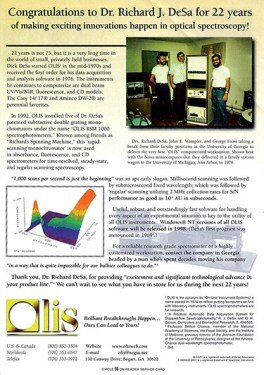Spectrophotometers Fundamentals Explained
Spectrophotometers Fundamentals Explained
Blog Article
The Definitive Guide to Circular Dichroism
Table of Contents5 Simple Techniques For Uv/visGet This Report on Circular DichroismThings about Uv/vis/nirSome Known Questions About Circularly Polarized Luminescence.The Of Uv/vis

Spectrophotometry is a tool that hinges on the quantitative analysis of molecules depending on how much light is taken in by colored substances.
The Of Spectrophotometers
A spectrophotometer is commonly used for the measurement of transmittance or reflectance of solutions, transparent or nontransparent solids, such as polished glass, or gases. Although lots of biochemicals are colored, as in, they soak up visible light and therefore can be determined by colorimetric procedures, even colorless biochemicals can frequently be converted to colored compounds ideal for chromogenic color-forming responses to yield compounds ideal for colorimetric analysis.: 65 Nevertheless, they can likewise be created to measure the diffusivity on any of the listed light varieties that generally cover around 2002500 nm using different controls and calibrations.
An example of an experiment in which spectrophotometry is used is the determination of the equilibrium constant of an option. A certain chain reaction within an option might occur in a forward and reverse direction, where reactants form products and items break down into reactants. Eventually, this chain reaction will reach a point of balance called a stability point.
The Main Principles Of Uv/vis
The amount of light that travels through the solution is indicative of the concentration of certain chemicals that do not allow light to pass through. The absorption of light is because of the interaction of light with the electronic and vibrational modes of molecules. Each type of particle has a private set of energy levels related to the makeup of its chemical bonds and nuclei and hence will take in light of specific wavelengths, or energies, resulting in unique spectral homes.
They are extensively utilized in lots of markets including semiconductors, laser and optical manufacturing, printing and forensic examination, as well as in laboratories for the study of chemical compounds. Spectrophotometry is frequently used in measurements of enzyme activities, determinations of protein concentrations, determinations of enzymatic kinetic constants, and measurements of ligand binding reactions.: 65 Eventually, a spectrophotometer is able to identify, depending on the control or calibration, what compounds are present in a target and precisely how much through calculations of observed wavelengths.
Created by Arnold O. Beckman in 1940 [], the spectrophotometer was produced with the aid of his coworkers at his business National Technical Laboratories established in 1935 which would become Beckman Instrument Business and eventually Beckman Coulter. This address would come as a service to the formerly created spectrophotometers which were not able to absorb the ultraviolet properly.
3 Simple Techniques For Uv/vis
It would be found that this did not give satisfactory outcomes, therefore in Design B, there was a shift from a glass to a quartz prism which enabled for much better absorbance outcomes - circularly polarized luminescence (https://nowewyrazy.uw.edu.pl/profil). From there, Model C was born with a modification to the wavelength resolution which ended up having three systems of it produced
It was produced from 1941 to 1976 where the rate for it in 1941 was US$723 (far-UV accessories were a choice at extra expense). In the words of Nobel chemistry laureate Bruce Merrifield, it was "most likely the most crucial instrument ever established towards the advancement of bioscience." Once it ended up being stopped in 1976, Hewlett-Packard produced the very first commercially offered diode-array spectrophotometer in 1979 referred to as the HP 8450A. It irradiates the sample with polychromatic light which the sample takes in depending on its residential or commercial properties. It is transferred back by grating the photodiode variety which spots the wavelength region of the spectrum. Since then, the creation and execution of spectrophotometry gadgets has actually increased immensely and has become one of the most innovative instruments of our time.

Indicators on Spectrophotometers You Should Know
The grating can either be movable or fixed.
In such systems, the grating is repaired and the intensity of each wavelength of light is determined by a different detector in the range. When making transmission measurements, the spectrophotometer quantitatively compares the portion of light that passes through a reference option and a test solution, then digitally compares the strengths of the 2 signals and computes the percentage of transmission of the sample compared to the referral standard.

Report this page